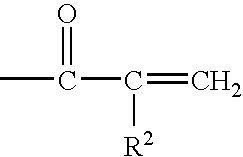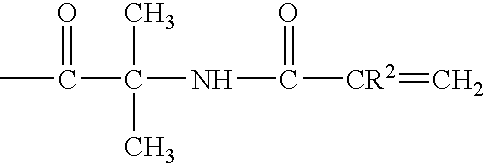Curable hydrophilic compositions
a composition and hydrophilic technology, applied in the field of cureable hydrophilic compositions, can solve the problems of inability to observe the treatment state from the outside, poor transparency, and scab typically formed in and as part of the pad
- Summary
- Abstract
- Description
- Claims
- Application Information
AI Technical Summary
Benefits of technology
Problems solved by technology
Method used
Image
Examples
example 1
[0177]To Nalco 2326 (100.00 grams) a solution of PEO / PPO-silane 1 (21.6 grams, 0.018 moles), SILQUEST A-174 (4.48 grams, 0.018 moles) and 1-methoxy-2-propanol (150 grams) was added slowly over 15 minutes. The mixture was heated to 80° C. with mechanical stirring for 24 hours. After cooling, M-PEG 400 A (30.00 grams) was added and the mixture was placed under vacuum to remove solvents. A clear, transparent solution was obtained (68.91 grams).
example 2
[0178]To Nalco 2326 (150.00 grams) a solution of SILQUEST A-174 (13.43 grams, 0.054 moles) and 1-methoxy-2-propanol (175 grams) was added slowly over 15 minutes. The mixture was heated to 80° C. with mechanical stirring for 24 hours. After cooling, HEMA (34.6 grams) was added and the mixture was placed under vacuum to remove solvents. A clear, transparent solution was obtained (87.5 grams).
example 3
[0179]To Nalco 2327 (100.00 grams) a solution of PEO / PPO-silane 2 (30.00 grams, 0.015 moles), SILQUEST A-174 (2.46 grams, 0.010 moles) and 1-methoxy-2-propanol (150 grams) was added slowly over 15 minutes. The mixture was heated to 80° C. with mechanical stirring for 24 hours. After cooling, M-PEG 300 MA (80.0 grams) was added and the mixture was placed under vacuum to remove solvents. A clear, transparent solution was obtained (154.2 grams). Example 4
[0180]To Nalco 2327 (50.00 grams) a solution of PEO / PPO-silane 2 (15.00 grams, 0.007 moles), SILQUEST A-174 (1.23 grams, 0.005 moles) and 1-methoxy-2-propanol (75 grams) was added slowly over 15 minutes. The mixture was heated to 80° C. with mechanical stirring for 24 hours. After cooling, M-PEG A 400 (40.0 grams) was added and the mixture was placed under vacuum to remove solvents. A clear, transparent solution was obtained (79.1 grams).
PUM
| Property | Measurement | Unit |
|---|---|---|
| Fraction | aaaaa | aaaaa |
| Fraction | aaaaa | aaaaa |
| Percent by mass | aaaaa | aaaaa |
Abstract
Description
Claims
Application Information
 Login to View More
Login to View More - R&D
- Intellectual Property
- Life Sciences
- Materials
- Tech Scout
- Unparalleled Data Quality
- Higher Quality Content
- 60% Fewer Hallucinations
Browse by: Latest US Patents, China's latest patents, Technical Efficacy Thesaurus, Application Domain, Technology Topic, Popular Technical Reports.
© 2025 PatSnap. All rights reserved.Legal|Privacy policy|Modern Slavery Act Transparency Statement|Sitemap|About US| Contact US: help@patsnap.com



